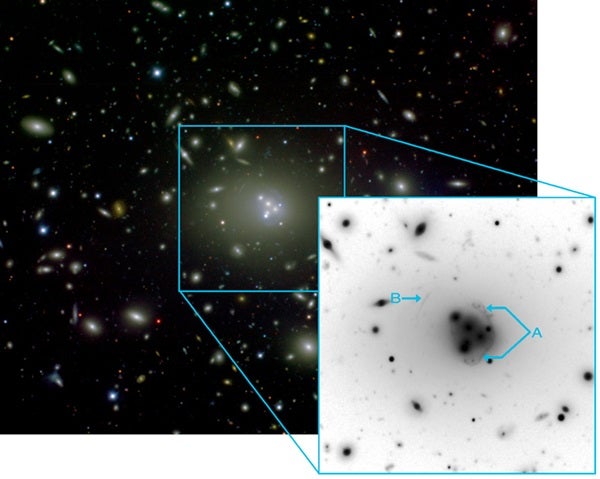A newly discovered gravitational lens in a relatively nearby galaxy cluster is leading astronomers to conclude that the cluster hosts the most massive galaxy known in our local universe. The study also reaffirms that galactic cannibalism is one reason that this galaxy is so obese, tipping the scales at up to 30 trillion times the mass of our Sun.
The supermassive galaxy is located at the core of the galaxy cluster Abell 3827, which lies about 1.4 billion light-years away. This galaxy and hundreds of its smaller cluster companions are visible in a dramatic new image released by the Gemini Observatory in Hilo, Hawaii.
Although this bright galaxy, ESO 146-IG 005, dominates the core of Abell 3827, “the magnitude of its appetite has not been fully appreciated,” said Gemini astronomer Rodrigo Carrasco. The Gemini observations revealed, for the first time, the effects of gravitational lensing near the core of ESO 146-IG 005.
A gravitational lens is created when a massive object, in this case the core of the supermassive galaxy, distorts its local space. Light from a background galaxy, in this case two galaxies, that is passing by appears deflected from its original path. From our perspective, we see the background galaxies’ light reshaped as a ringlike structure that arcs around the lensing object. These arcs from both galaxies are clearly visible in the new Gemini images.
“The gravitational lens we discovered allowed us to estimate for the first time the mass of this monster galaxy very accurately,” said Carrasco. “The inferred mass is a factor of 10 greater than previous estimates derived from X-ray observations. Assuming our model is correct, this is by far the most massive galaxy known in our local universe.”
The exceptional galaxy was not simply born massive; it has grown by consuming its companions in perhaps the most extreme example of ongoing “galaxy cannibalism” known. “This unabashed cannibal is something of a messy eater, with the partially digested remains of at least four smaller galaxies still visible near its center,” said Michael West, astronomer at the European Southern Observatory (ESO) in Chile, who first observed this system more than a decade ago and says that he was immediately struck by the complex morphology of this giant cannibal galaxy. “Eventually, this galaxy will grow even bigger judging by the number of nearby galaxies already within its gravitational grasp.”
These observations yield important insight into the process of galaxy growth, especially of elliptical galaxies. These galaxies do not appear to acquire their full mass quickly in the early universe, but instead they show significant growth through mergers and cannibalism at later times, after many of their stars have formed. The resulting galaxies, such as this one, can be extremely massive.
The Gemini observations were made using the Gemini Multi-Object
Spectrograph (GMOS) on the Gemini South telescope in Chile. Follow-up spectroscopic observations used the same instrument to confirm the distances (redshifts) of the two background galaxies whose light is diverted by the gravitational potential of the cluster core. These two galaxies were found to lie at about 2.7 and 5.1 billion light-years away (redshifts z = 0.2 and 0.4, respectively).










